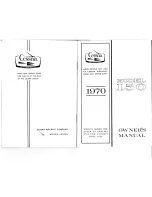
Oldtimer XXL-59
Building instructions - Oldtimer XXL-59
7
outboard wing panels at an angle of nine degrees from perpendicular. Check the fit repeatedly, to avoid sanding
away too much material.
•
Glue the inboard and outboard panels together with 5-minute epoxy, using the jig which you previously employed
when assembling the wing pylon.
•
Allow the joints to harden fully before very carefully sanding the joint areas smooth and flush.
Remaining work
•
The wing pylon can now be glued to the top of the fuselage: the first
step is to check that the tabs are a snug fit in the slots, and that the
pylon rests squarely on the fuselage without wobbling.
•
Plug the wing panels into the pylon on both sides, and sight along the
fuselage from the nose to check whether the wing and pylon are
horizontal relative to the building board. You can easily check this by
packing up both wings at the same point using CD cases or similar.
•
When you are satisfied, glue the pylon to the fuselage using 5-minute
epoxy. Position it accurately as previously, then leave the glue to set
hard.
•
Any gaps between the pylon and the top of the fuselage can be filled
later with epoxy or white glue.
•
This completes the model’s bare airframe. Give the whole model a final rub-down with fine (240-grit) abrasive paper,
and check that all surfaces are smooth and true. At this stage it is a good idea to examine the model carefully for
inadequate glued joints, and excess blobs of glue which can be scraped away.
•
Now that you have built your own model, you can be justifiably proud of your modelling skills and workmanship.
Covering
•
We recommend that you cover the airframe with a lightweight iron-on film such as ‘Ora-Light’, or the old classic
tissue paper. Under no circumstances use iron-on fabric, as this material is too heavy and shrinks too strongly, i.e. it
would cause serious warps in the delicate structure of the “Oldtimer XXL-59”.
•
When applying the covering material be sure to follow the instructions supplied by the manufacturer.
Installing the RC system and power train
•
Use a little 5-minute epoxy to glue the plastic horns in the rudder and elevator, exactly in line with the snake sleeves
where they exit the fuselage. Connect the pre-formed end of the steel pushrods to the horns.
•
Mount swivel pushrod connectors on the output arms of the two servos before screwing them to the servo plate. Set
the servos to centre from the transmitter, hold the control surfaces at centre, then slip the pushrods through the
connector barrels and tighten the clamping screws.
•
The electric motor is simply screwed to the inside of the firewall at the extreme nose of the fuselage. Mark the motor
mounting holes on the firewall to suit the motor you intend to use. Ventilation holes are not necessary with such low
power levels; they would only weaken the firewall unnecessarily.
•
The central hole for the motor shaft should be a few millimetres larger than the diameter of the shaft itself.
•
The speed controller can be attached to the bottom of the fuselage with a small patch of hook-and-loop tape; keep
the connecting leads as short as possible. Don’t wrap the controller in foam, as this would prevent cooling air
reaching it.
•
The flight battery is located directly below the wing, and is fitted and removed through the hatch on the underside of
the fuselage. Secure it with hook-and-loop tape.
Settings
•
Set the control surface travels as follows:
Elevator: 10 mm up, 10 mm down
Rudder: 15 mm left, 15 mm right
•
The model should balance at a point 72 mm aft of the wing root leading edge. Support the model on two fingertips on
both sides of the wing pylon at this point: the fuselage nose should now be inclined slightly down. If necessary,
correct the Centre of Gravity by re-positioning the flight battery or adding a small amount of lead ballast to nose or
tail.
•
Carry out a range-check before the first flight - with and without the motor running.
Safety notes, potential hazards
•
Model flying is a fascinating hobby. However, model aircraft have the potential to annoy and even injure people, so
we strongly recommend that you observe a few basic rules in order to avoid these hazards.
•
In Germany and many other countries you are only permitted to fly model aircraft using a radio control system oper-


























